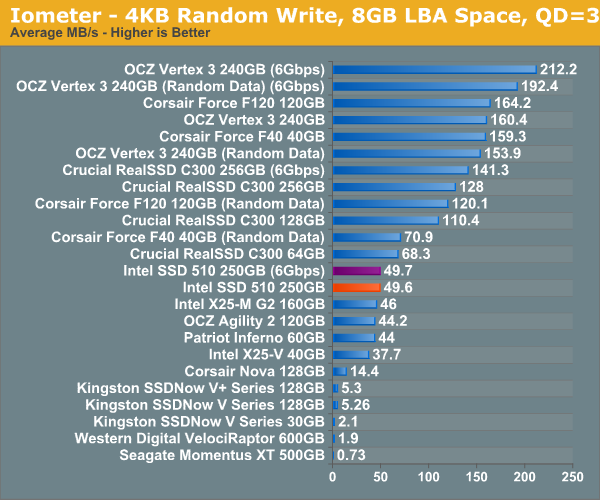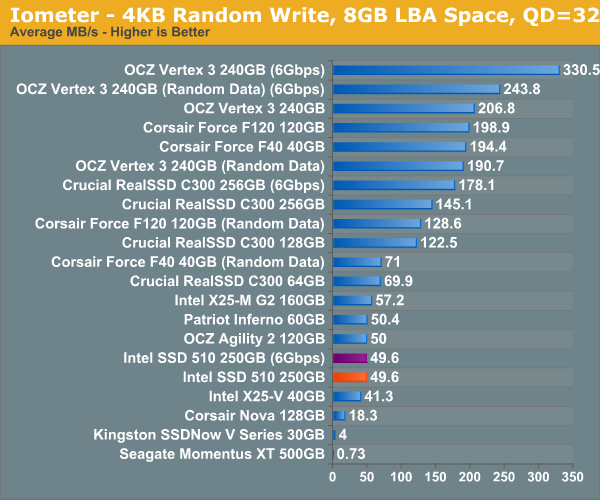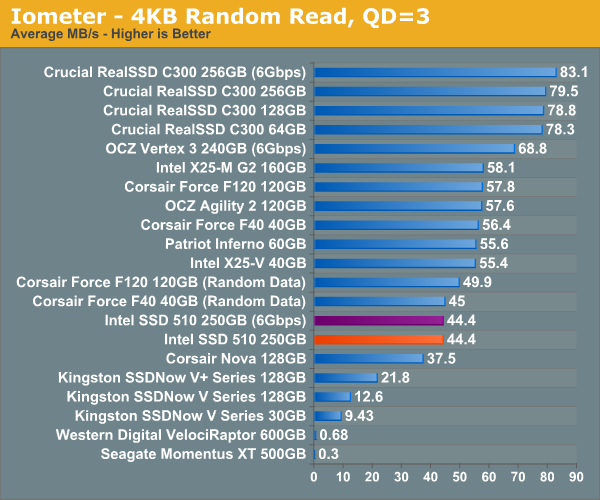The Intel SSD 510 Review
by Anand Lal Shimpi on March 2, 2011 1:23 AM EST- Posted in
- IT Computing
- Storage
- SSDs
- Intel
- Intel SSD 510
Random Read/Write Speed
The four corners of SSD performance are as follows: random read, random write, sequential read and sequential write speed. Random accesses are generally small in size, while sequential accesses tend to be larger and thus we have the four Iometer tests we use in all of our reviews.
Our first test writes 4KB in a completely random pattern over an 8GB space of the drive to simulate the sort of random access that you'd see on an OS drive (even this is more stressful than a normal desktop user would see). I perform three concurrent IOs and run the test for 3 minutes. The results reported are in average MB/s over the entire time. We use both standard pseudo randomly generated data for each write as well as fully random data to show you both the maximum and minimum performance offered by SandForce based drives in these tests. The average performance of SF drives will likely be somewhere in between the two values for each drive you see in the graphs. For an understanding of why this matters, read our original SandForce article.

It's a bit unfortunate for Intel that we happen to start our performance analysis with a 4KB random write test in Iometer. The 510's random write performance is only marginally better than the X25-M G2 at 49.7MB/s. The RealSSD C300 is faster, not to mention the SF-1200 based Corsair Force F120 and the SF-2200 based OCZ Vertex 3.
Although not depicted here, max write latency is significantly reduced compared to the X25-M G2. While the G2 would occasionally hit a ~900ms write operation, the 510 keeps the worst case latency to below 400ms. The Vertex 3 by comparison has a max write latency of anywhere from 60ms - 350ms depending on the type of data being written.
Many of you have asked for random write performance at higher queue depths. What I have below is our 4KB random write test performed at a queue depth of 32 instead of 3. While the vast majority of desktop usage models experience queue depths of 0 - 5, higher depths are possible in heavy I/O (and multi-user) workloads:

While the X25-M G2 scaled with queue depth in our random write test, the 510 does not. It looks like 50MB/s is the absolute highest performance we'll see for constrained 4KB random writes. Note that these numbers are for 4KB aligned transfers, performance actually drops down to ~40MB/s if you perform sector aligned transfers (e.g. performance under Windows XP).

Random read performance is just as disappointing. The X25-M G2 took random read performance seriously but the 510 is less than 20% faster than the Indilinx based Corsair Nova. When I said the Intel SSD 510's random performance is decidedly last-generation, I meant it.










128 Comments
View All Comments
aarste - Wednesday, March 2, 2011 - link
Those graphs on the TRIM test look nothing remotely close to ATTO, which I use. I checked HDTach as well and it wasn't that, but close.What app was it?
mino - Wednesday, March 2, 2011 - link
Please, be so king and include a fast HDD (say a WD Velociraptor) in EVERY SSD benchmark.While most readers here understand the difference between SSD and HDD, including a single fast HDD would make the article useful also as a reference/datapoint when talking to not-so-techy people.
strikeback03 - Thursday, March 3, 2011 - link
Then people would complain because the numbers are so small as to be unreadablenerex - Wednesday, March 2, 2011 - link
Maybe I missed it, but i didn't see any discussion of the power usage of the new drives- according the intel press releases, the new drives use 380mW/100mW active/idle and the G2 drives only use 150mW/75mW active/idle.This means the new drives would actually be worse on laptop battery life, correct?
DigitlDrug - Saturday, March 5, 2011 - link
Hi Anand,+1
Power consumption figures would be great for us laptop users!
I find it interesting that a number of these drives report consumption of up to 3watts and others are in the mw range when browsing the Egg.
Some clarity on power consumption would be a great addition.
As always, great review!
ClagMaster - Wednesday, March 2, 2011 - link
The Intel SSD 510 is not a bad drive but it cost more than a Vertex 2 or 3.The Intel Toolbox, and extensive compatablity and reliability testing are major pluses.
The SSD is still an extravagance for desktops though I can see its a no-brainer for laptops because of power conservation. Unless the cost per gigabyte is less than $0.80/gigabyte, the performance gain does not offset the mechanical harddrive.
neotiger - Wednesday, March 2, 2011 - link
I.e., an epic FAIL product priced at a premium to competing products that are far superior.What misguided priorities from Intel. People shell out the big bucks for SSD's for their RANDOM IO performance, NOT sequential IO. So the geniuses at Intel decided to release a "next gen" product that actually has WORSE performance than the last gen product. Really?
I'm speechless. The really sad part about this fiasco is that most people will still buy this piece of crap over far superior competing products just because it's Intel.
Just like NetBurst all over again.
strikeback03 - Thursday, March 3, 2011 - link
Did you actually look at the real-world results? the 510 is almost twice as fast as the G2 160GB in some tests.poohbear - Wednesday, March 2, 2011 - link
nice review, but you're talking & comparing the Vertex 3 and this new drive, but where's the vertex 3 on the market? its not even released, its months away from release if im not mistaken? the C400 will be released before it, so what's the point of comparing tech today with tech months away from release (and in the SSD world months is a very long time!)sor - Wednesday, March 2, 2011 - link
FWIW, we've deployed literally hundreds of X25-E drives, and our failure rate is well over 1%, closer to 2%. Usually they drop link, try to renegotiate at 1.5Gbps, and fail, so it's more likely the controller than a wear-out issue.